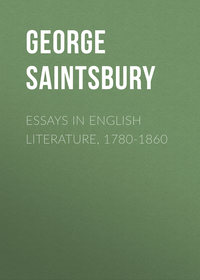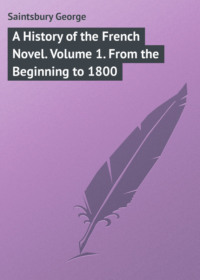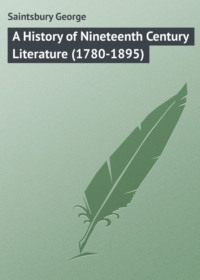 полная версия
полная версияA Short History of French Literature
23
Ed. P. Paris. Paris, 1848.
24
Ed. Boca. Valenciennes, 1841.
25
Ed. Schéler. Brussels, 1877.
26
Ed. Barrois. Paris, 1842.
27
There exists a Provençal version of it, evidently translated from the French. The most convenient edition is that of Kroeber and Servois, Paris, 1860. There is an English fourteenth-century version published by Mr. Herrtage for the Early English Text Society, 1879.
28
Published partially by MM. P. Paris and E. du Méril and by Herr Stengel.
29
Ed. Le Glay. Paris, 1840.
30
Ed. Michel. Paris, 1856.
31
Ed. La Grange. Paris, 1864.
32
Ed. Guessard. Paris, 1866.
33
Ed. Guessard et Grandmaison. Paris, 1860.
34
Ed. Michelant. Stuttgart, 1862.
35
Ed. Michel. Paris, 1839.
36
Ed. Schéler. Brussels, 1874.
37
Ed. Pey. Paris, 1859.
38
Ed. Tarbé. Rheims, 1850.
39
Ed. Michel. London, 1836.
40
It is very commonly said that this feature is confined to the later Chansons. This is scarcely the fact, unless by 'later' we are to understand all except Roland. In Roland itself the presentment is by no means wholly complimentary.
41
The Turoldus of Roland has been already noticed. Of certain or tolerably certain authors, Graindor de Douai (revisions of the early crusading Chansons of 'Richard the Pilgrim,' Antioche, &c.), Jean de Flagy (Garin), Bodel (Les Saisnes), and Adenès le Roi, a fertile author or adapter of the thirteenth century, are the most noted.
42
Ferabras and Betonnet d'Hanstone. M. Paul Meyer has recently edited this latter poem under the title of Daurel et Beton (Paris, 1880). To these should be added a fragment, Aigar et Maurin, which seems to rank with Girartz.
43
There has been some reaction of late years against the scepticism which questioned the 'Provençal Epic.' I cannot however say, though I admit a certain disqualification for judgment (see note at beginning of next chapter), that I see any valid reason for this reaction.
44
Oc and oil (hoc and hoc illud), the respective terms indicating affirmation. In this chapter the information given is based on a smaller acquaintance at first hand with the subject than is the case in the chapters on French proper. Herr Karl Bartsch has been the guide chiefly followed.
45
Essay on Ranke's History of the Popes.
46
See chap. i.
47
See chap. x.
48
The poem on Boethius. See chap. i.
49
By the school of the so-called Félibres, of whom Mistral and Aubanel are the chief.
50
Moland and Héricault's Introduction to Aucassin et Nicolette. Paris, 1856.
51
Nennius, a Breton monk of the ninth century, has left a brief Latin Chronicle in which is the earliest authentic account of the Legend of Arthur. Geoffrey of Monmouth, circa 1140, produced a Historia Britonum, avowedly based on a book brought from Britanny by Walter, Archdeacon of Oxford. No trace of this book, unless it be Nennius, can be found. See note at end of chapter.
52
Department of Seine-et-Marne, near Fontainebleau.
53
Map as a person belongs rather to English than to French history. He lived in the last three quarters of the twelfth century.
54
These various Romances are not by any means equally open to study in satisfactory critical editions. To take them chronologically, M. Hucher has published Robert de Borron's Little Saint Graal in prose, his Percevale, and the Great Saint Graal, with full and valuable if not incontestable notes, 3 vols.; Le Mans, 1875-1878. The verse form of the Little Saint Graal was published by M. F. Michel in 1841. An edition of Artus was promised by M. Paulin Paris, but interrupted or prevented by his death. The great works of Map, Lancelot and the Quest, as well as the Mort Artus, have never been critically edited in full; and the sixteenth-century editions being rare and exceedingly costly, as well as uncritical, they are not easily accessible, except in M. Paris' Abstract and Commentary, Les Romans de la Table Ronde, 5 vols., 1869-1877. Tristan was published partially forty years ago by M. F. Michel. Merlin was edited in 1886 by M. G. Paris and M. Ulrich. A complete edition of Chrestien de Troyes has been undertaken by Dr. Wendelin Förster and has preceded to its second volume (Yvain). This under its second title of Le Chevalier au Lyon has also been edited by Dr. Holland (third edition 1886). Besides this there is the great Romance of Percevale (continued by others, especially a certain Manessier), of which M. Potvin has given an excellent edition, 6 vols., Mons, 1867-1872, including in it a previously unknown prose version of the Romance of very early date; Le Chevalier à la Charrette, continued by Godefroy de Lagny, and edited, with the original prose from Lancelot du Lac, by Dr. Jonckbloet (The Hague, 1850); and Erec et Énide, by M. Haupt (Berlin, 1860). This piecemeal condition of the texts, and the practical inaccessibility of many of them, make independent judgment in the matter very difficult. What is wanted first of all is a book on the plan of M. Léon Gautier's Epopées Françaises, giving a complete account of all the existing texts – for the entire editing of these latter must necessarily take a very long time. The statements made above represent the opinions which appear most probable to the writer, not merely from the comparison of authorities on the subject, but from the actual study of the texts as far as they are open to him. (See note at end of Chapter.)
55
This expression occurs in the Chanson des Saisnes, i. 6. 7: 'Ne sont que iij matières a nul home atandant, De France et de Bretaigne et de Rome la grant.'
56
Ed. Michelant. Stuttgart, 1846.
57
Li Cors, otherwise li tors 'the crooked.' Since this book was first written M. Paul Meyer has treated the whole subject of the paragraph in an admirable monograph, Alexandre le Grand dans la Littérature Française du Moyen Age, 2 vols. Paris, 1886.
58
Ed. Joly. Rouen, 1870.
59
Moland and Héricault's Nouvelles du XIVème Siècle. Paris, 1857. Joly, Op. cit. See also P. Stapfer, Shakespeare et l'Antiquité. 2 vols. Paris, 1880.
60
The first collection of Fabliaux was published by Barbazan in 1756. This was re-edited by Méon in 1808, and reinforced by the same author with a fresh collection in 1823. Meanwhile Le Grand d'Aussy had (1774-1781) given extracts, abstracts, and translations into modern French of many of them. Jubinal, Robert, and others enriched the collection further, and in vol. xxiii. of the Histoire Littéraire M. V. Le Clerc published an excellent study of the subject. A complete collection of Fabliaux has, however, only recently been attempted, by M. M. A. de Montaiglon and G. Raynaud (6 vols., Paris, 1872-1888).
61
Fabliau is, of course, the Latin fabula. The genealogy of the word is fabula, fabella, fabel, fable, fablel, fableau, fabliau. All these last five forms exist.
62
It should be noticed that this title, though consecrated by usage, is a misnomer. It should be Roman de Renart, for this latter is a proper name. The class name is goupil (vulpes). The standard edition is that of Méon (4 vols., Paris, 1826) with the supplement of Chabaille, 1835. This includes not merely the Ancien Renart, but the Couronnement and Renart le Nouvel. Renart le Contrefait has never been printed. Rothe (Paris, 1845) and Wolf (Vienna, 1861) have given the best accounts of it. Recently M. Ernest Martin has given a new critical edition of the Ancien Renart (3 vols., Strasburg and Paris, 1882-1887).
63
The necessary expression of the genitive by de is later than this. Mediaeval French retained the inflection of nouns, though in a dilapidated condition. Properly speaking Renars is the nominative, Renart the general inflected case.
64
This is a free translation of the last line of the original, which is as follows: —
Pour renard qui gelines tue,
Qui a la rousse peau vestue,
Qui a grand queue et quatre piés,
N'est pas ce livre communiés;
Mais pour cellui qui a deux mains
Dont il sont en ce siècle mains,
Qui ont sous la chappe Faulx Semblant.
Wolf, Op. cit. p. 5.
The final allusion is to a personage of the Roman de la Rose.
65
Ed. Roquefort, vol. ii. See next chapter.
66
By Dr. W. Förster. Heilbronn, 1882.
67
Leipsic, 1870.
68
See note at end of chapter.
69
This miscellaneous lyric for the most part awaits collection and publication. M. G. Raynaud has given a valuable Bibliographie des Chansonniers Français des XIIIe et XIVe siècles. 2 vols., Paris, 1884. Also a collection of motets. Paris, 1881.
70
Philippe Mouskès. This is it:
La terre fut pis en cest anQuar li vieux Quesnes estoit mors.71
The best edition is in Schéler's Trouvères Belges. Brussels, 1876.
72
Rheims, 1851.
73
The most convenient place to look for Adam's history and work is Le Théâtre Français au Moyen Age. Par Monmerqué et Michel. Paris, 1874. There are also separate editions of him by Coussemaker, and more recently by A. Rambeau. Marburg, 1886.
74
By A. Jubinal. 2nd edition. 3 vols. Paris, 1874.
75
Ed. Roquefort. 2 vols. Paris, 1820. The first volume contains the lays; the later the fables, which have been noticed in the last chapter. Later edition, Warnke. Halle, 1885. Marie also wrote a poem on the Purgatory of St. Patrick. Three other lays, Tidorel, Gringamor, and Tiolet have been attributed to her, and are printed in Romania, vol. viii.
76
Lays of France, London, 1872.
77
This is an account of the battle of thirty Englishmen and thirty Bretons in the Edwardian wars.
78
There is, it appears, no authority for the Christian name of Robert which used to be given to Wace.
79
Wace's Brut is not the only one. The title seems to have become a common name.
80
The old edition of the Roman de Rou, by Pluquet, has been entirely superseded by that of Dr. Hugo Andresen. 2 vols. Heilbronn, 1877-1879.
81
Discovered recently in the Middlehill collection, and known chiefly by an article in Romania (Jan. 1882), giving an abstract and specimens.
82
Ed. Reiffenberg. Brussels, 1835-1845.
83
Ed. Schéler. Brussels, 1866-1868.
84
Well edited by Koch. Heilbronn, 1879.
85
See especially Hysminias and Hysmine.
86
Ed. F. Michel. 2 vols. Paris, 1864.
87
Dangier is not exactly 'danger.' To be 'en dangier de quelqu'un' is to be 'in somebody's power.' Dangier is supposed to stand for the guardian of the beloved, father, brother, husband, etc. This at least has been the usual interpretation, and seems to me to be much the more probable. M. Gaston Paris, however, and others, see in Dangier the natural coyness and resistance of the beloved object, not any external influence.
88
Chaucer's authorship of the existing translation has been denied. It is, however, certain that he did translate the poem.
89
Ed. Stehlich. Halle, 1881.
90
Ed. Förster. Berne, 1880.
91
Ed. Schéler. Brussels, v. d.
92
Ed. van Hasselt. Brussels, 1866.
93
The wooden horse.
94
The Songe d'Enfer and the Voie de Paradis, published by Jubinal, as the Roman des Eles has been by Schéler, Méraugis by Michelant, and the Vengeance de Raguidel by Hippeau.
95
Ed. Crapelet. Paris, 1834.
96
Ed. Du Méril. Paris, 1856.
97
Ed. Brunet et Montaiglon. Paris, 1856.
98
Ed. Michelant. Paris, 1867.
99
Ed. Meyer. Paris, 1875.
100
Ed. Michelant. Paris, 1876.
101
Ed. Hippeau. Paris, 1863.
102
Ed. Hippeau. Paris, 1860.
103
Ed. Förster. Halle, 1877.
104
Ed. Stengel. Tübingen, 1873.
105
Both edited in extract by Bordier. Paris, 1869. Complete edition begun by Suchier. Paris, 1884.
106
Ed. Hofmann and Muncker. Halle, 1880.
107
Ed. Michel.
108
Ed. Boca. 2 vols. Valenciennes, 1841.
109
Ed. Schéler. Brussels, 1877.
110
The following is an account of these forms, in their more important developments. The ballade consists of three stanzas, and an envoy, or final half-stanza, which is sometimes omitted. The number of the lines in each stanza is optional, but it should not usually be more than eleven or less than eight. The peculiarity of the poem is that the last line of every stanza is identical, and that the rhymes are the same throughout and repeated in the same order. The examples printed at the end of this chapter from Lescurel and Chartier will illustrate this sufficiently. There is no need to enter into the absurdity of ballades équivoquées, emperières, etc., further than to say that their main principle is the repetition of the same rhyming word, in a different sense, it may be twice or thrice at the end of the line, it may be at the end and in the middle, it may be at the end of one line and the beginning of the next. The chant royal is a kind of major ballade having five of the longest (eleven-lined) stanzas and an envoy of five lines. The rondel is a poem of thirteen lines (sometimes made into fourteen by an extra repetition), consisting of two quatrains and a five-lined stanza, the first two lines of the first quatrain being repeated as the last two of the second, and the first line of all being added once more at the end. The rondeau, a poem of thirteen, fourteen, or fifteen lines, is arranged in stanzas of five, four, and four, five, or six lines, the last line of the second and third stanzas consisting of the first words of the first line of the poem. The triolet is a sort of rondel of eight lines only, repeating the first line at the fourth, and the first and second at the seventh and eighth. Lastly, the villanelle alternates one of two refrain lines at the end of each three-lined stanza. These are the principal forms, though there are many others.
111
Ed. Montaiglon. Paris, 1855.
112
The Rondeau is not in Lescurel systematised into any regular form.
113
Ed. L. de Mas Latrie. Société de l'Orient Latin, Geneva, 1877. This is a poem not much shorter than the Voir Dit, but continuously octosyllabic and very spirited. The final account of the murder of Pierre (which he provoked by the most brutal oppression of his vassals) is full of power.
114
Ed. P. Paris. Société des Bibliophiles, Paris, 1875. This is a very interesting poem consisting of more than 9000 lines, mostly octosyllabic couplets, with ballades, etc. interspersed, one of which is given at the end of this chapter. It is addressed either to Agnes of Navarre, or, as M. P. Paris thought, to Péronelle d'Armentières, and was written in 1362, when the author was probably very old.
115
Deschamps is said to have been also named Morel. A complete edition of his works has been undertaken for the Old French Text Society by the Marquis de Queux de Saint Hilaire.
116
Ballades, 147, 149. Ed. Queux de St. Hilaire.
117
Ed. Schéler. 3 vols. Brussels, 1870-1872.
118
Ed. Héricault. 2 vols. Paris, 1874. Charles d'Orléans was the son of the Duke of Orleans, who was murdered by the Burgundians, and of Valentina of Milan. He was born in 1391, taken prisoner at Agincourt, ransomed in 1449, and he died in 1465. His son was Louis XII.
119
Ed. Queux de St. Hilaire. Paris, 1868.
120
These, as well as The Ten Virgins and many other pieces soon to be mentioned, are to be found in Monmerqué and Michel, Théâtre François au Moyen Age, Paris, 1874, last ed.; Adam, ed. Luzarches, 1854.
121
Vols. 1-6. Paris, 1876-1881.
122
Ed. G. Paris and G. Raynaud. Paris, 1878.
123
Ed. J. de Rothschild. Vols. i-iii. Paris, 1878-1881.
124
Mystère du Viel Testament, i. 259-272.
125
Miracles de la Vierge, ii. 1-54.
126
See Monmerqué and Michel, op. cit.
127
Ancien Théâtre Français, vols. 1-3. Paris, 1854.
128
Paris, n. d.
129
Ancien Théâtre Français, ii. 64-79.
130
A history of the mediaeval theatre has been undertaken by M. Petit de Julleville, of which two volumes, containing an excellent account of the Mysteries, have appeared (Paris, 1880). Information on other points is rather scattered, but it will be found well summarised in Aubertin, Histoire de la Langue et de la Littérature Française au Moyen Age (Paris, 1876-8), i. 372-570. A complete collection of farces, soties, etc. is hoped for from the Old French Text Society.
131
The chronicle of the pseudo-Turpin is of little real importance in the history of French literature, because it is admitted to have been written in Latin. The busy idleness of critics has however prompted them to discuss at great length the question whether the Chanson de Roland may not possibly have been composed from this chronicle. The facts are these. Tilpin or Turpin was actually archbishop of Rheims from 753-794, but nobody pretends that the chronicle going under his name is authentic. All that is certain is that it is not later than 1165, and that it is probably not earlier than the middle, or at most the beginning, of the eleventh century, while the part of it which is more particularly in question is of the end of that century. Roland is almost certainly of the middle at latest. Curiosity on this point may be gratified by consulting M. Gaston Paris, De pseudo-Turpino, Paris, 1865, or M. Léon Gautier, Epopées Françaises, Paris, 1878. But, from the literary point of view, it is sufficient to say that, while Turpin is of the very smallest literary merit, Roland is among the capital works of the middle ages.
132
Ed. N. de Wailly. Paris, 1874.
133
Ed. P. Paris. 2 vols., 1879-80. It is characteristic of the middle ages that this work usually bore the title of Roman d'Eracle, for no other reason than that the name of Héraclius occurs in the first sentence.
134
Ed. N. de Wailly. Paris, 1874. Besides the Histoire de St. Louis, Joinville has left an interesting Credo, a brief religious manual written much earlier in his life.
135
Ed. Kervyn de Lettenhove. 20 vols., Brussels. Ed. S. Luce, Paris, in course of publication. The edition of Buchon, 3 vols., Paris, 1855, is still the best for general use. Froissart's poems give many biographical details which are interesting, but unimportant. He wandered all his life from court to court, patronised and pensioned by kings, queens, and princes. He was successively curé of Lestines and canon of Chimay. In early life he was much in England, being specially patronised by Edward III. and Philippa.
136
Old Mortality, chap. 35.
137
Ed. Buchon. Paris, 1858.
138
Chastellain has been fortunate, like most Flemish writers, in being excellently and completely edited (by M. Kervyn de Lettenhove. 8 vols., Brussels).
139
Ed. Michaud et Poujoulat.
140
Ed. Michaud et Poujoulat.
141
Ed. Michaud et Poujoulat, in whose collection most of the many authors here mentioned will be also found.
142
Ed. Montaiglon. Paris, 1854.
143
A good example of these is the Saint Voyage de Jérusalem of the Seigneur d'Anglure (1385), edited by MM. Bonnardot and Longnon. Paris, 1878.
144
Nouvelles du 13e et du 14e siècle. Ed. Moland et Héricault. 2 vols. Paris, 1856.
145
Paris, 1876.
146
Paris, 1858.
147
Ed. Settegast. Halle, 1881.
148
Ed. Guichard. Paris, 1843.
149
Ed. Jannet. Paris, 1853; 2nd ed. 1857.
150
Ed. Wright. Paris, 1858.
151
Ed. Fournier, Théâtre Français avant la Renaissance. Paris, n. d.










